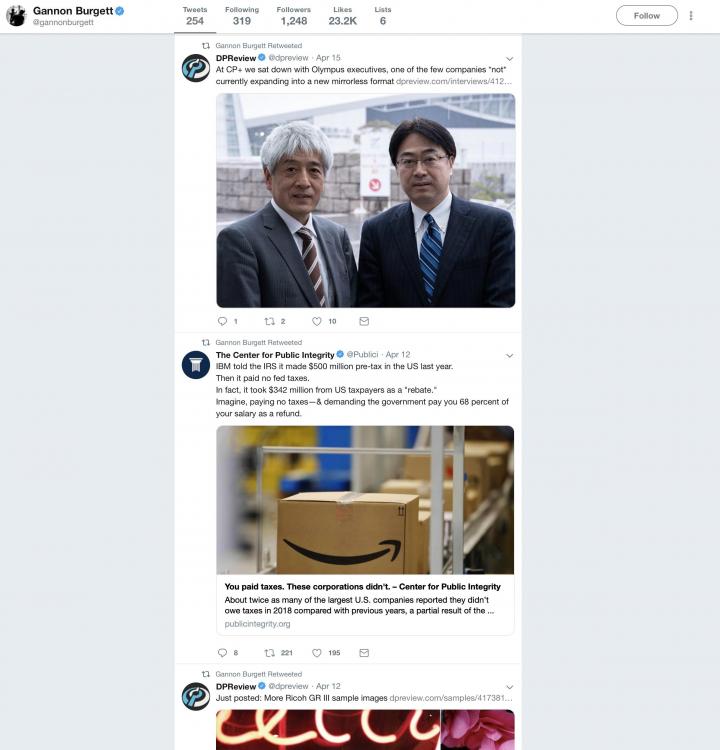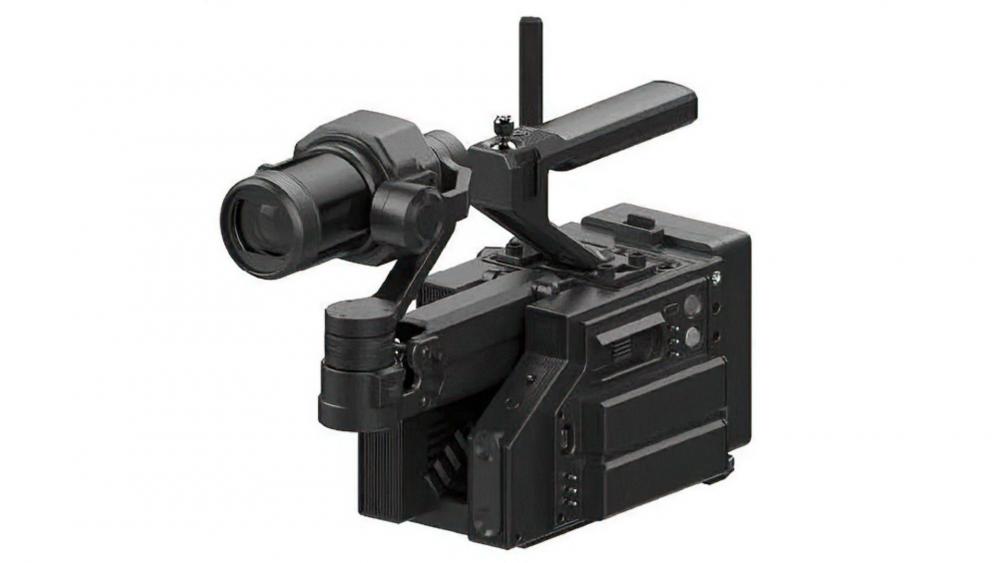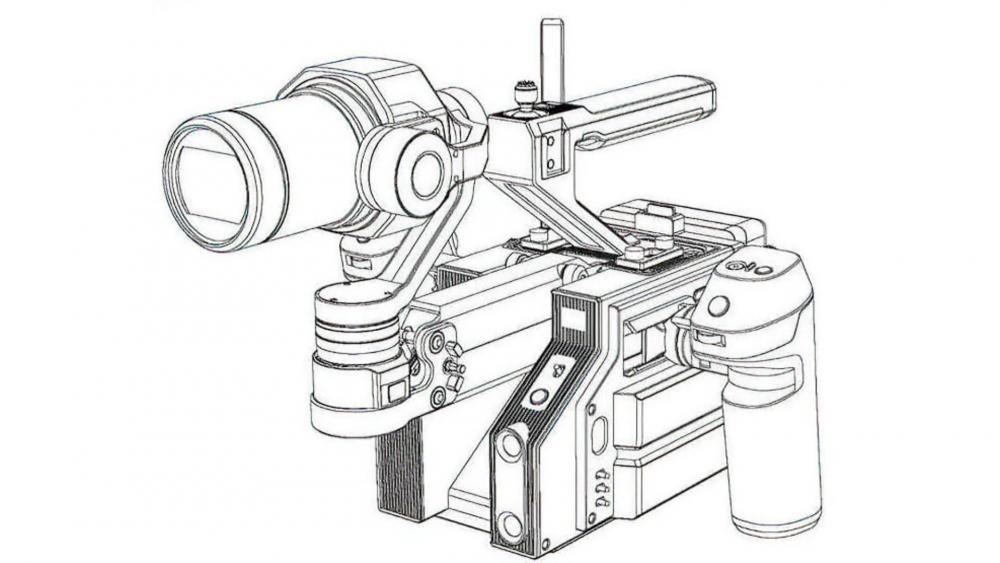-
Posts
15,298 -
Joined
-
Last visited
Content Type
Profiles
Forums
Articles
Everything posted by Andrew Reid
-
The Huawei one has them for breakfast, especially the shameful Samsung rush job. https://consumer.huawei.com/uk/phones/mate-x/
-

Nikon Z6 features 4K N-LOG, 10bit HDMI output and 120fps 1080p
Andrew Reid replied to Andrew Reid's topic in Cameras
Why does he say you need an external recorder? It's not worse than any other mirrorless camera for monitoring, in fact the screen is better than most and the EVF is too. Should have shot Z-LOG then -
Barney Britton has responded to say he is now consigning all my emails to his spam folder and breaking off communications. If he won't remove the ban on EOSHD at DPReview, then Amazon will. And I sent him this: -------- Barney It isn’t a closed matter or a case for the spam folder for me. I will be taking things to Amazon, putting in a complaint with them about the negative impression your forum ban is creating for EOSHD, the censorship of your own users and the damage it has caused to the reputation of my site. No doubt I will be pointing out the history of copyright infringement and slander on your forum to them as well, because I have screenshots of posts that were left up for months before being deleted. As well as the inconvenience the forum URL ban places on your users (and Amazon’s customers), it means that Google is picking up EOSHD related topics and discussions on your forum, placing these above the original topics on EOSHD and they are all orphaned without a link to the source, damaging the SEO ranking of my site and causing material harm to my income. The forum ban has been in place for how many years now - 3? 4? You have over several years wound me up to such an extent that you’ve created a negative impression with other staff at DPReview such as with Scott, Chris and Jordan, as well as your forum users. It’s an absolute disgrace. I didn’t have a problem with anyone else at DPReview apart from you and Shawn. Gannon makes a string of idiotic mistakes, but you’re persistently insidious. Think about that next time you have the cheek to ask me to seek to edit my opinions on my own forum. Andrew -------- At least I managed to refrain from calling him a cock-womble this time. Time to turn my focus to Amazon, after all they are the real boss. It is time for Amazon to put an end to the personal vendettas.
-
Oh yes there it is, Amazon paying his salary so he can sit down with Olympus in one moment, then him criticising them publicly for tax fraud the next... Principled guy! Maybe he should run that Amazon tax story on the front page of DPReview as well?!
-
The ban makes it look like I am hosting illegal content or have done something so terrible that DPReview are protecting their users from my site. Any person interested in Pro Color or C-LOG has a broken censored link to contend with so that's lost sales right there. This is what you get from Barney when you criticise the DPReview news feed for clickbait. Good job nobody bought a Fran 8K after seeing it hyped on there by Gannon, isn't it. The Cinemartin bloke's now bankrupt and I hope nobody got burnt. Maybe I should ask DPReview to take down all my video page reviews like for the 5D Mark III and GH4 they got me to write, as well. They sell ads and Amazon links around my content, whilst threatening me with the law. Nice.
-
Unfortunately this ban has never been lifted. 3 years now and running now. I've had people pirating links to my Shooter's Guides on the DPReview forum and found it difficult to get mods to take it down. People cannot link to the genuine URLs at EOSHD. Unfortunately Barney Britton at DPReview (https://***URL removed***/about/staff/barneybritton) doesn't like me, and won't lift the forum ban on the domain name. I may need to ask some of you for help. If you have a DPReview forum account, or a way to contact the moderators, I think we need a campaign to lift this ban once and for all. On top of this, Barney has accused me of libel and has forwarded my emails to Amazon's legal counsel. He wanted me to take down the posts about the Sigma MC-21 adapter on this forum and the comments about the Fran 8K news piece Gannon wrote at DPReview. If anyone can help, please do. Now's the time.
-
On the other hand the Nikon Z 50mm F1.8 is actually surprisingly not boring. I am quite enjoying using it. Very good AF in video mode too. Nikon gave up altogether giving the F0.95 autofocus, I see. It's going to be a tank, that tanks sales wise as well. It makes the RF 50 1.2 look balanced in terms of size. The new Voigtlander 50mm F1.2 Asph is the best rendering and best overall performing smallest, highest 50mm F1.2 on the market right now. In stills mode that can be autofocuses on the Techart adapter on E-mount, and soon on Z mount too. The AF is fast, and moves entire lens, so optically that is superior to moving just one element. I find it very practical and don't mind the few MM the lens moves during use. Hand doesn't block the movement even when cradling the lens. I wish Canon would do a smaller softer 50mm F1.2 with more vignetting, and internal focussing elements, no larger than existing EF version, but I guess the pixel peepers would be up and arms about it.
-
In or out? It's the big question facing the British today. Native lenses for mirrorless cameras offer all sorts of advantages. They can be smaller. They can be video optimised with internal autofocus. Canon themselves said recently: "With the move to mirrorless the aim is to optimise the space where the mirror box used to be - that was what we were looking at. This allows us to make the lenses smaller and also to raise the optical quality." So how's it going making the lenses smaller? If you imagine at the Canon factory they have a range of levers to prioritise. When it came to planning his lens, the man on the optical quality lever pushed fully forward. The man on the price lever wrenched it as far forward as it could go. The man on the size lever was drunk, his entire body slumped forward on the lever. The man on the video autofocus lever was absent in entirety, and the factory sign in book empty for months. In fact the Japanese police think he may have been abducted by the Yakuza. Read the full review
-
Leaving out 1080/24p is that final push by Canon to get pros to use certain higher-end cameras instead. Fuck customer goodwill towards brand or customer loyalty. It's an extra $1 they want.
-
The codec quality is similar to the 1D C, actually a little less compressed per frame as 1D C is ALL-I, so needs a higher bitrate (as each frame is compressed separately). As 8bit goes the E-M1X is one of the best. Get exposure right in-camera and you'll be good to go.
-

NAB 2019 predictions and major talking points - BMPCC 4K Pro anyone?!
Andrew Reid replied to Andrew Reid's topic in Cameras
-
They could have used older lenses to make it less clinically sharp, but apart from that I thought the image looked very cinematic.
-
Happy birthday!
-
Seems he didn't check the date when he uploaded it on the 31st March
-

NAB 2019 predictions and major talking points - BMPCC 4K Pro anyone?!
Andrew Reid replied to Andrew Reid's topic in Cameras
Aren't they entitled to do that? -
Shot externally with an Atomos in HLG 10bit mode (higher bitrate than internal) Looks pretty good to me, and a hint of what the internal codec upgrade will look like. I also feel for a promo film it's above average, a very simple story but effective. A bit sentimental of course, and not perfect attention to detail in some shots, but it works. I hope one day when I hear a piece of music it will remind me of the Panasonic S1, when I was young enough to shoot stuff and not too old and crippled to use a camera
-

NAB 2019 predictions and major talking points - BMPCC 4K Pro anyone?!
Andrew Reid replied to Andrew Reid's topic in Cameras
I like Wooden Camera's stuff and a sun hood is a good idea, working with what we've got. Problem is we've got too little. Price is good. Now let's raise it by $1000 and see a Pro version. -

NAB 2019 predictions and major talking points - BMPCC 4K Pro anyone?!
Andrew Reid replied to Andrew Reid's topic in Cameras
What's the point of the big bad screen on the back of the Pocket then? They may as well have left it off. It sucks up power and doesn't point in the direction you need it to, and you can barely see it in sun light. Of course, nobody in Blackmagic pointed this out to the design team! -

NAB 2019 predictions and major talking points - BMPCC 4K Pro anyone?!
Andrew Reid replied to Andrew Reid's topic in Cameras
It would probably just be easier to add ProResRAW internal recording to E-M1X or future GH6 40 minutes at best and sometimes camera turns off at 50% so hardly reliable YES to that. Where is a new Ninja Star?! If they can power it via USB C with no need for Canon LP, even better. Modern chips very efficient and at same time powerful. -
NAB 2019 begins this weekend and exhibits open to the public on Monday 8th. One of the big talking points this year I think will be DaVinci Resolve 16 and hopefully we will see a big swing away from Adobe Premiere for editing as a result. Adobe will also unveil updates at NAB but I am uninterested, as I really do think their reliability isn't fit for pro work any more, or any kind of work for that matter. On the camera side it looks a bit quiet so far. Canon confused us all with the EOS R external RAW recording tweet, but it's entirely possible their reps don't know the difference between external HDMI recording and RAW any way. Read the full article
-
Nice shots, especially the first two. Why 4:3?
-
NAB starts tomorrow








